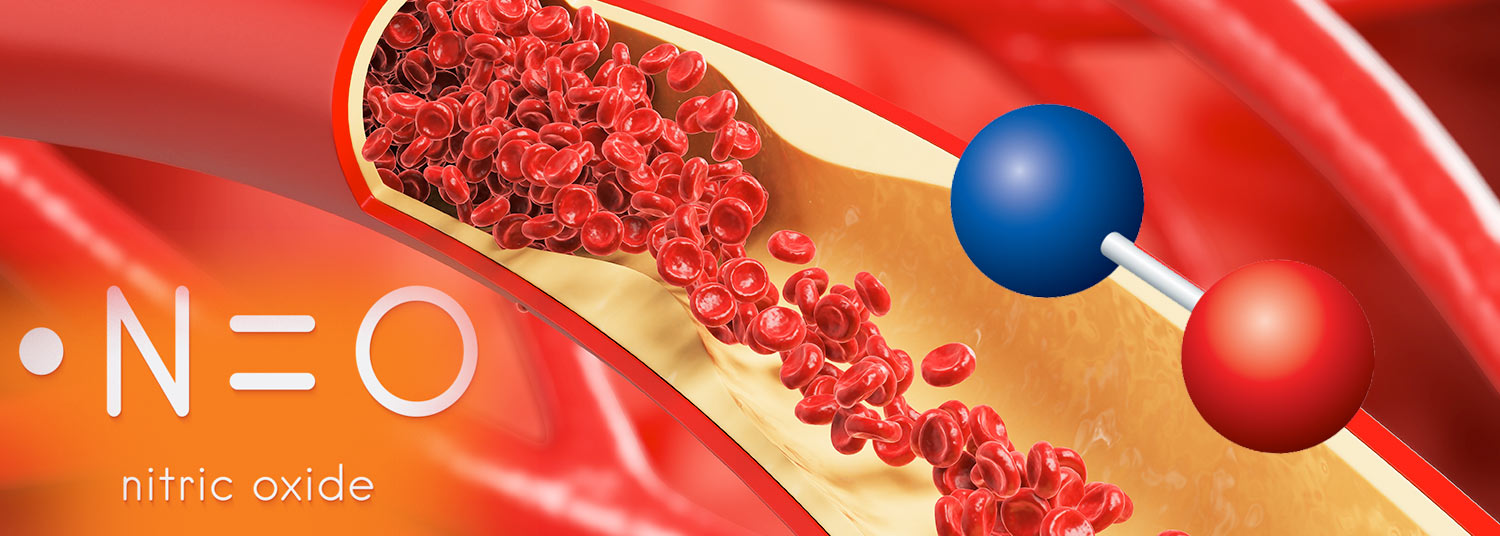September 14, 2023 | Deborah Kotz
A Signaling Role of Nitric Oxide in Regulating Blood Flow Involves Important “Middleman” Molecule
In the 25 years since the Nobel Prize was awarded for discovering the role that nitric oxide (NO) plays in the cardiovascular system, researchers have been racing to learn more about how this mysterious signaling molecule works to repair blood vessels damaged by a heart attack, stroke or other cardiovascular event. University of Maryland School of Medicine (UMSOM) researchers and their Wake Forest University (WFU) colleagues today announced an important missing piece of the puzzle.

While the signaling roles of NO have been studied extensively over the past three decades, researchers have yet to understand how this short-lived molecule travels from blood to signaling targets in the blood vessel wall. To address this gap, the team led by UMSOM and WFU researchers characterized the formation of a stable NO intermediary called NO-ferroheme. The team demonstrated in animal studies that, after injection, NO-ferroheme is transported in blood, often bound to albumin, and travels to the blood vessels and causes them to dilate, lowering blood pressure.
“We know that nitric oxide -- with its extremely short half-life of less than a second in blood -- must have a way of moving through the bloodstream and into blood vessels via a stable mechanism,” said study lead author Anthony DeMartino, PhD, Assistant Professor of Medicine at UMSOM. “We worked out the chemistry and the kinetics of how NO-ferroheme is physiologically generated in the test tube, and then demonstrated how it works in an animal model, which provides strong evidence of our hypothesis.”
To conduct their studies, the research team decided to investigate heme, best known for its role in oxygen delivery (via hemoglobin) in the blood, but also a common signaling target for NO. They mixed ferric heme (an oxidized form of the compound that can cause cellular damage) with NO and the antioxidant glutathione (found in high levels in most cells) to see how they would react in a laboratory setting.

“My laboratory has worked for more than two decades trying to understand how NO can diffuse in blood and in cells without being destroyed by reactions with other radicals and heme bound proteins like hemoglobin and myoglobin. The stabilization of NO by forming NO-ferroheme allows it to diffuse across distances, almost like a chemical flying saucer, to directly bind to and activate target enzymes that control blood flow,” said study lead and corresponding author Mark T. Gladwin, MD, UMSOM Dean and Vice President for Medical Affairs, University of Maryland, Baltimore, and the John Z. and Akiko K. Bowers Distinguished Professor. “The NO-ferroheme can also bind to albumin, which is the most abundant protein in our blood. We hypothesize that NO-ferroheme-albumin can be developed as a drug to target different disease states where NO is impaired such as pulmonary hypertension, diabetes, and obesity.”

"One of the most surprising things that came out of our study was the role of the glutathione; both in the novel chemistry in forming the NO ferroheme and in its effects in vivo,” said Dr. Kim-Shapiro. “We still have a lot more work to do to fully understand this."
There are many complicated facets to NO that researchers have yet to unravel. They know it has Jekyll and Hyde characteristics with beneficial effects in the vasculature to improve blood flow to arteries and tissues as well as in immune defense, where NO is used by macrophages to kill invading bacteria. At the same time, NO is poisonous at high doses and can be utilized by cancer cells to increase blood flow, causing tumors to quickly grow or to help cancer cells spread.
Uncovering NO-ferroheme as a biological “middleman” represents an important step towards understanding the nuanced signaling mechanisms of NO both under healthy conditions and in myriad disease states.
The research team next want to explore the mechanism of how NO-ferroheme is imported into vascular cells needed to trigger the observed signaling.
They also want to further investigate the use of NO-ferroheme as a potential therapeutic. A pressing need is for new therapeutics to treat damage to blood vessels called ischemia-reperfusion injuries. These injuries -- triggered by the loss of oxygen to arteries after, say, a stroke or cardiac arrest – often lead to permanent tissue damage. Having a safe drug to quickly restore blood flow to effected tissues could potentially help mitigate the devastating effects of these cardiovascular events.
Qinzi Xu, MD, Assistant Professor of Medicine at UMSOM, and Jason Rose, MD, MBA, Associate Professor of Medicine and Associate Dean, Innovation & Physician Science Development at UMSOM, were co-authors of this study. Other study co-authors were from Wake Forest University in Winston-Salem, NC, and the University of Pittsburgh in Pittsburgh, PA.
This work was funded by the National Institutes of Health (HL125886 and HL098032) and from funding from the Department of Defense (W81XWH2210198).
Contact
Deborah Kotz
dkotz@som.umaryland.edu
410-804-0054
Related stories

Thursday, August 18, 2022
Senior Academic Leader and Internationally Recognized Scientist Christopher P. O'Donnell, PhD, Appointed Vice Dean for Research Development and Operations at UM School of Medicine
University of Maryland School of Medicine (UMSOM) Dean Mark T. Gladwin, MD announced today that Christopher P. O’Donnell, PhD, Associate Vice Chancellor for Emerging Technologies in Health Sciences Education at the University of Pittsburgh, has been named Vice Dean for Research Development and Operations at the UMSOM, effective September 1, 2022. Dr. O’Donnell, who has led the integration of diverse digital technology learning initiatives across Pitt Health Sciences, joins Dean Gladwin as part of UMSOM’s senior leadership team. Dr. Gladwin began his tenure as Dean at UMSOM on August 1.

Tuesday, October 06, 2020
UM School of Medicine Scientist Receives Prestigious NIH Director's New Innovator Award
$2.3 million Award Targeted for “High-Risk, High Reward” Research that Aims to Understand Contribution of Blood Flow to Brain Plasticity

